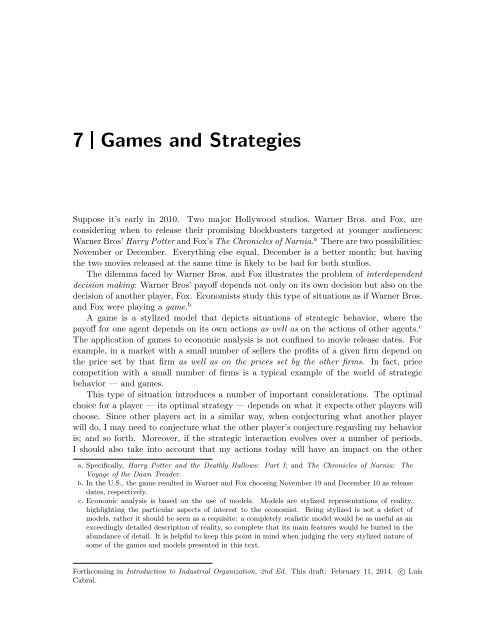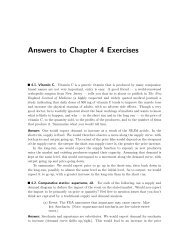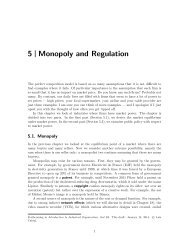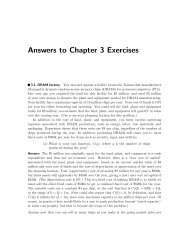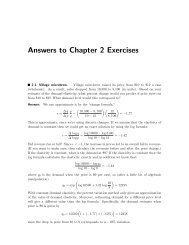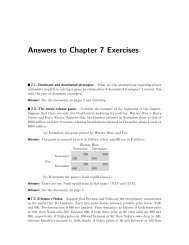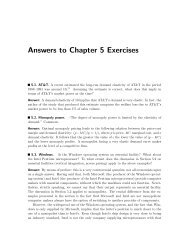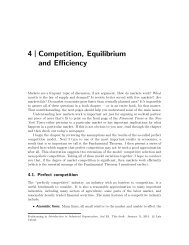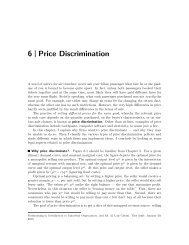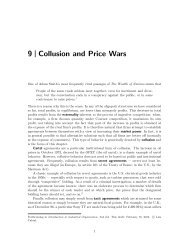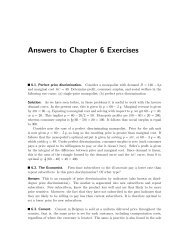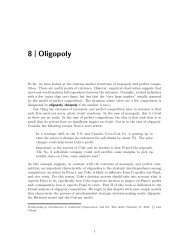7 Games and Strategies - Luiscabral.net
7 Games and Strategies - Luiscabral.net
7 Games and Strategies - Luiscabral.net
Create successful ePaper yourself
Turn your PDF publications into a flip-book with our unique Google optimized e-Paper software.
7 <strong>Games</strong> <strong>and</strong> <strong>Strategies</strong><br />
Suppose it’s early in 2010. Two major Hollywood studios, Warner Bros. <strong>and</strong> Fox, are<br />
considering when to release their promising blockbusters targeted at younger audiences:<br />
Warner Bros’ Harry Potter <strong>and</strong> Fox’s The Chronicles of Narnia. a There are two possibilities:<br />
November or December. Everything else equal, December is a better month; but having<br />
the two movies released at the same time is likely to be bad for both studios.<br />
The dilemma faced by Warner Bros. <strong>and</strong> Fox illustrates the problem of interdependent<br />
decision making: Warner Bros’ payoff depends not only on its own decision but also on the<br />
decision of another player, Fox. Economists study this type of situations as if Warner Bros.<br />
<strong>and</strong> Fox were playing a game. b<br />
A game is a stylized model that depicts situations of strategic behavior, where the<br />
payoff for one agent depends on its own actions as well as on the actions of other agents. c<br />
The application of games to economic analysis is not confined to movie release dates. For<br />
example, in a market with a small number of sellers the profits of a given firm depend on<br />
the price set by that firm as well as on the prices set by the other firms. In fact, price<br />
competition with a small number of firms is a typical example of the world of strategic<br />
behavior — <strong>and</strong> games.<br />
This type of situation introduces a number of important considerations. The optimal<br />
choice for a player — its optimal strategy — depends on what it expects other players will<br />
choose. Since other players act in a similar way, when conjecturing what another player<br />
will do, I may need to conjecture what the other player’s conjecture regarding my behavior<br />
is; <strong>and</strong> so forth. Moreover, if the strategic interaction evolves over a number of periods,<br />
I should also take into account that my actions today will have an impact on the other<br />
a. Specifically, Harry Potter <strong>and</strong> the Deathly Hallows: Part I; <strong>and</strong> The Chronicles of Narnia: The<br />
Voyage of the Dawn Treader.<br />
b. In the U.S., the game resulted in Warner <strong>and</strong> Fox choosing November 19 <strong>and</strong> December 10 as release<br />
dates, respectively.<br />
c. Economic analysis is based on the use of models. Models are stylized representations of reality,<br />
highlighting the particular aspects of interest to the economist. Being stylized is not a defect of<br />
models, rather it should be seen as a requisite: a completely realistic model would be as useful as an<br />
exceedingly detailed description of reality, so complete that its main features would be buried in the<br />
abundance of detail. It is helpful to keep this point in mind when judging the very stylized nature of<br />
some of the games <strong>and</strong> models presented in this text.<br />
Forthcoming in Introduction to Industrial Organization, 2nd Ed. This draft: February 11, 2014.<br />
Cabral.<br />
c○ Luís
players’ beliefs <strong>and</strong> actions in the future. In summary, payoff interdependence introduces a<br />
host of possibilities for strategic behavior — the object of game theory.<br />
Elements of game theory. The basic element of game theory <strong>and</strong> applied game theory<br />
is a game. A game consists of a set of players, a set of rules (who can do what when) <strong>and</strong> a<br />
set of payoff functions (the utility each player gets as a result of each possible combination<br />
of strategies). Figure 7.1 depicts a simple game which exemplifies these ideas. There are<br />
two players, Player 1 <strong>and</strong> Player 2. Player 1 has two possible strategies, T <strong>and</strong> B, which<br />
we represent as Player 1 choosing a row in the matrix represented in Figure 7.1. Player 2<br />
also has two possible strategies, L <strong>and</strong> R, which we represent by the choice of a column in<br />
the matrix in Figure 7.1.<br />
For each combination of strategies by each player, the respective matrix cell shows the<br />
payoffs received by each player. In the lower left corner, the payoff received by Player 1; in<br />
the top right corner, the payoff received by Player 2. A crucial aspect of a game is that each<br />
player’s payoff is a function of the strategic choice by both players. In Figure 7.1, this is<br />
represented by a matrix, where each cell corresponds to a combination of strategic choices<br />
by each player. This form of representing games is know as normal form. Later we will<br />
consider alternative forms of representing a game.<br />
Simultaneous vs. sequential decisions. One final point regarding the game is Figure<br />
7.1 is the “rule” that both players choose their strategies simultaneously. This rule will be<br />
maintained throughout a number of examples in this chapter — in fact, throughout much of<br />
the book. Therefore, I should clarify its precise meaning. In real life, very seldom do agents<br />
make decisions at precisely the same time. A firm will make a strategic investment decision<br />
this week, its rival will do it in two or three weeks’ time. So how realistic is the assumption<br />
that players choose strategies at the same time? Suppose that there is an observation lag,<br />
that is, suppose that it takes time for Player 2 to observe what Player 1 chooses; <strong>and</strong><br />
likewise, suppose that it takes time for Player 1 to observe what Player 2 chooses. In this<br />
context, it is perfectly possible that players make decisions at different times but that, when<br />
decisions are made, neither player knows what the other player’s choice is. In other words,<br />
it is as if players were simultaneously choosing strategies. Naturally, the assumption that<br />
observation lags are very long does not always hold true. Later in the chapter, we will find<br />
examples where an explicit assumption of sequential decision making is more appropriate.<br />
7.1. Nash equilibrium<br />
A game is a model, a stylized description of a real-world situation. The purpose of formulating<br />
such a model is to underst<strong>and</strong> (<strong>and</strong> predict) behavior patterns, in this case strategic<br />
behavior patterns. In other words, we would like to “solve” the game, that is, determine the<br />
strategies we expect each player to follow. This can be important for descriptive analysis<br />
(underst<strong>and</strong>ing why a certain player chooses a certain strategy) as well as for prescriptive<br />
analysis (advising a player what strategy to choose). In this section, I consider various<br />
possible avenues for “solving” a game.<br />
Dominant <strong>and</strong> dominated strategies. Consider again the game in Figure 7.1. What<br />
strategies would we expect players to choose? Take Player 1’s payoffs, for example. If<br />
2
Figure 7.1<br />
The “prisoner’s dilemma” game<br />
Player 1<br />
T<br />
B<br />
5<br />
6<br />
Player 2<br />
L R<br />
5<br />
3<br />
3<br />
4<br />
6<br />
4<br />
Player 1 expects Player 2 to choose L, then Player 1 is better off by choosing B instead of<br />
T . In fact, B would yield a payoff of 6, which is more than the payoff from T , 5. Likewise,<br />
if Player 1 expects Player 2 to choose R, then Player 1 is better off by choosing B instead<br />
of T . In this case, Player 1’s payoffs are given by 3 <strong>and</strong> 4, respectively. In summary, Player<br />
1’s optimal choice is B, regardless of what Player 2 chooses.<br />
Whenever a player has a strategy that is strictly better than any other strategy regardless<br />
of the other players’ strategy choices, we say that the first player has a dominant strategy.<br />
A dominant strategy yields a player the highest payoff for each <strong>and</strong> every choice by the<br />
other players.<br />
If a player has a dominant strategy <strong>and</strong> if the player is rational — that is, payoff maximizing<br />
— then we should expect the player to choose the dominant strategy. Notice that all we<br />
need to assume is that the player is rational. In particular, we do not need to assume that<br />
the other players are rational. In fact, we do not even need to assume the first player knows<br />
the other players’ payoffs. The concept of dominant strategy is very robust.<br />
The structure of the game presented in Figure 7.1 is very common in economics, in<br />
particular in industrial organization. For example, strategies T <strong>and</strong> L might correspond to<br />
setting a high price, whereas B <strong>and</strong> R correspond to setting a low price. What is interesting<br />
about this game is that (a) both players are better off by choosing (T, L), which gives each<br />
player a payoff of 5; however, (b) Player 1’s dominant strategy is to play B <strong>and</strong> Player 2’s<br />
dominant strategy is to play R; (c) For this reason, players chose (B, R) <strong>and</strong> receive (4,4),<br />
which is less than the commonly beneficial outcome (5,5).<br />
In other words, the game in Figure 7.1, which is commonly known as the prisoner’s<br />
dilemma, depicts the conflict between individual incentives <strong>and</strong> joint incentives. Jointly,<br />
players would prefer to move from (B, R) to (T, L), boosting payoffs from (4,4) to (5,5).<br />
However, individual incentives are for Player 1 to choose B <strong>and</strong> for Player 2 to choose<br />
R. In Chapters 8 <strong>and</strong> 9, we will see that many oligopoly situations have the nature of a<br />
“prisoner’s dilemma.” We will also see in what ways firms can escape the predicament of<br />
lowering payoffs from the “good” outcome (5,5) to the “bad” outcome (4,4).<br />
Consider the game in Figure 7.2. There are no dominant strategies in this game. In<br />
fact, more generally, very few games have dominant strategies. We thus need to find other<br />
ways of “solving” the game. Consider Player 1’s decision. While Player 1 has no dominant<br />
strategy, Player 1 has a dominated strategy, namely M. In fact, if Player 2 chooses L,<br />
3
Figure 7.2<br />
Dominated strategies<br />
Player 1<br />
T<br />
M<br />
B<br />
1<br />
0<br />
2<br />
Player 2<br />
L C R<br />
2<br />
0<br />
0<br />
1<br />
0<br />
-2<br />
0<br />
3<br />
1<br />
1<br />
0<br />
2<br />
1<br />
0<br />
2<br />
then Player 1 is better off by choosing T than M. The same is true for the cases when<br />
Player 2 chooses C or R. That is, M is dominated by T from Player 1’s point of view. More<br />
generally,<br />
A dominated strategy yields a player a payoff which lower than that of a different<br />
strategy, regardless of what the other players do.<br />
The idea is that, if a given player has a dominated strategy <strong>and</strong> that player is rational, then<br />
we should expect that player not to choose such a strategy.<br />
Notice that the definition of a dominated strategy calls for there being another strategy<br />
that dominates the strategy in question. A strategy is not necessarily dominated even if, for<br />
each opponent strategy, we can find an alternative choice yielding a higher payoff. Consider<br />
Figure 7.2 again <strong>and</strong> suppose that Player 1’s payoff from the (T, R) strategy combination is<br />
−3 instead of 1. Then, for each possible choice by Player 2, we can find a choice by Player<br />
1 that is better than M: if Player 2 chooses L, then T is better than M; if Player 2 chooses<br />
C, then T <strong>and</strong> B are better than M; <strong>and</strong> if Player 2 chooses R, then B is better than M.<br />
However, M is not a dominated strategy in this alternative game: there is no other strategy<br />
for Player 1 that guarantees a higher payoff than M regardless of Player 2’s choice.<br />
The concept of dominated strategies has much less “bite” than that of dominant strategies.<br />
If Player 1 has a dominant strategy, we know that a rational Player 1 will choose<br />
that strategy; whereas if Player 1 has a dominated strategy all we know is that it will not<br />
choose that strategy; in principle, there could still be a large number of other strategies<br />
Player 1 might choose. Something more can be said, however, if we successively eliminate<br />
“dominated” strategies. (The justification for quotation marks around “dominated” will<br />
soon become clear.)<br />
Suppose that Player 2 knows Player 1’s payoffs <strong>and</strong>, moreover, knows that Player 1 is<br />
rational. By the reasoning presented earlier, Player 2 should expect Player 1 not to choose<br />
M. Given that Player 1 does not choose M, Player 2 finds strategy C to be “dominated”<br />
by R. Notice that, strictly speaking, C is not a dominated strategy: if Player 1 chooses M<br />
then C is better than R. However, C is dominated by R given that M is not played by<br />
Player 1.<br />
We can now take this process one step further. If Player 1 is rational, believes that<br />
4
Figure 7.3<br />
Dubious application of dominated strategies<br />
Player 2<br />
L R<br />
Player 1<br />
T<br />
B<br />
0<br />
1 1<br />
0<br />
-100 2<br />
1<br />
1<br />
Player 2 is rational, <strong>and</strong> believes that Player 2 believes that Player 1 is rational, then<br />
Player 1 should find T to be a “dominated” strategy (in addition to M). In fact, if Player<br />
2 does not choose C, then strategy T is “dominated” by strategy B: if Player 2 chooses<br />
L, Player 1 is better off with B; if Player 2 chooses R, again, Player 1 is better off with<br />
B. Finally, if we take this process one step further, we conclude that L is a “dominated”<br />
strategy for Player 2. This leaves us with the pair of strategies (B, R).<br />
As in the first example, we have reached a single pair of strategies, a “solution” to<br />
the game. However, the assumptions necessary for iterated elimination of “dominated”<br />
strategies to work are much more stringent than in the case of dominant strategies. Whereas<br />
in the first example all we needed to assume was that players are rational, payoff maximizing<br />
agents, we now assume that each player believes that the other player is rational.<br />
To underst<strong>and</strong> the importance of these assumptions regarding rationality, consider the<br />
simple game in Figure 7.3. Player 2 has a dominated strategy, L. In fact, it has a dominant<br />
strategy, too (R). If Player 1 believes that Player 2 is rational, then Player 1 should expect<br />
Player 2 to avoid L <strong>and</strong> instead play R. Given this belief, Player 1’s optimal strategy is to<br />
play B, for a payoff of 2. Suppose, however, that Player 1 entertains the possibility, unlikely<br />
as it might be, that Player 2 is not rational. Then B may no longer be its optimal choice,<br />
since there is a chance of Player 2 choosing L, resulting in a payoff of −100 for Player 1. A<br />
more general point is that, in analyzing games,<br />
It is not only important whether players are rational: it is also important whether<br />
players believe the other players are rational.<br />
Absolute <strong>and</strong> relative payoff. The game in Figure 7.3 also raises the issue of what<br />
rationality really means. In game theory, we take it to imply that players seek to maximize<br />
their payoff. However, many students, faced with the game in Figure 7.3, expect Player 2<br />
to choose L: while it implies a lower payoff for Player 2 (0 instead of 1) it also gives Player<br />
1 a very negative payoff. In other words, the outcome (B, L) looks favorable to Player 2 in<br />
the sense that Player 2 “wins” by a very favorable margin. Given that Player 1 chooses B,<br />
Player 2 would get a greater payoff by choosing L, but it would “lose” to Player 1, in the<br />
sense that it would receive a lower payoff than Player 1.<br />
Although this is a frequent interpretation of games like that in Figure 7.3, in differs<br />
from the game theory approach. Instead, we assume that each rational player’s goal is to<br />
5
Figure 7.4<br />
A game with no dominant or dominated strategies<br />
Player 2<br />
L C R<br />
T<br />
2<br />
1 2<br />
0 0<br />
3<br />
Player 1<br />
M<br />
1<br />
1 1<br />
1 1<br />
0<br />
B<br />
0<br />
1 0<br />
2 2<br />
2<br />
maximize his or her payoff. It is quite possible that one component of a player’s payoff is<br />
the success (or lack thereof) of rival players. If that is the case, then we should include it<br />
explicitly as part of the player’s payoff. For example, suppose that the values in Figure 7.3<br />
correspond to mo<strong>net</strong>ary payoffs; <strong>and</strong> that each player’s payoff is equal to the cash payoff<br />
plus a relative performance component computed as follows: earning one extra dollar more<br />
than the rival is equivalent to earning 10 cents in cash. Then the relevant game payoffs,<br />
given that Player 1 chooses B, would be (−110, +10) (if Player 2 chooses L) <strong>and</strong> (2.1, 0.9)<br />
(if Player 2 chooses R). d<br />
Nash equilibrium. Consider now the game in Figure 7.4. There are no dominant or<br />
dominated strategies in this game. Is there anything we can say about what to expect<br />
players will choose? In this game, more than in the previous games, it is apparent that each<br />
player’s optimal strategy depends on what the other player chooses. We must therefore<br />
propose a conjecture by Player 1 about Player 2’s strategy <strong>and</strong> a conjecture by Player<br />
2 about Player 1’s strategy. A natural c<strong>and</strong>idate for a “solution” to the game is then a<br />
situation whereby (a) players choose an optimal strategy given their conjectures of what<br />
the other players do <strong>and</strong> (b) such conjectures are consistent with the other players’ strategy<br />
choice.<br />
Suppose that Player 1 conjectures that Player 2 chooses R; <strong>and</strong> that Player 2 conjectures<br />
that Player 1 chooses B. Given these conjectures, Player 1’s optimal strategy is B, whereas<br />
Player 2’s optimal strategy is R. In fact, if Player 1 conjectures that Player 2 chooses R,<br />
then B is Player 1’s optimal choice; any other choice would yield a lower payoff. The same<br />
if true for Player 2. Notice that, based on these strategies, the players’ conjectures are<br />
consistent: Player 1 expects Player 2 to choose what in fact Player 2 finds to be an optimal<br />
strategy, <strong>and</strong> vice-versa. This situation is referred to as a Nash equilibrium. 1<br />
Although the concept of Nash equilibrium can be defined with respect to conjectures,<br />
it is simpler — <strong>and</strong> more common — to define it with respect to strategies.<br />
d. It would follow in this case that R is no longer a dominant strategy for Player 2 <strong>and</strong> as a result that<br />
Player 1 is better off by choosing T .<br />
6
Figure 7.5<br />
Best responses<br />
Player 2’s<br />
strategy<br />
L<br />
C<br />
R<br />
Player 1’s<br />
strategy<br />
T<br />
Player 1’s<br />
best response<br />
T<br />
B<br />
B<br />
Player 2’s<br />
best response<br />
R<br />
M {L,C }<br />
B<br />
R<br />
Player 1<br />
T<br />
M<br />
B<br />
Player 2<br />
L C R<br />
1 2<br />
2 ∗ 0<br />
1<br />
0<br />
1 ∗<br />
1<br />
1<br />
1 ∗<br />
0<br />
1<br />
3 ∗<br />
0<br />
0 2 ∗<br />
2 ∗ 2 ∗<br />
A pair of strategies constitutes a Nash equilibrium if no player can unilaterally change<br />
its strategy in a way that improves its payoff.<br />
It can be checked that, in the game in Figure 7.4, (B, R) is a Nash equilibrium <strong>and</strong> no<br />
other combination of strategies is a Nash equilibrium. For example, (M, C) is not a Nash<br />
equilibrium because, given that Player 2 chooses C, Player 1 would rather choose T .<br />
Best responses. A useful way to find a game’s Nash equilibrium is to derive each<br />
player’s best response. Player 1’s best response is a mapping that indicates Player 1’s best<br />
strategy for each possible strategy by Player 2. The left panels in Figure 7.5 shows Player<br />
1’s (top) <strong>and</strong> Player 2’s (bottom) best-response mapping. For example, if Player 2 chooses<br />
L, then Player 1 gets 2 from playing T , 1 from playing M, <strong>and</strong> 0 from playing B. It follows<br />
that Player 1’s best response to Player 2 choosing L is given by T ; <strong>and</strong> so forth. Regarding<br />
Player 2’s best response, notice that, if Player 1 chooses M, then L <strong>and</strong> C all are equally<br />
good choices for Player 2 (<strong>and</strong> better than R). For this reason, Player 2’s best response<br />
corresponds to the set {L, C}.<br />
How are best responses related to Nash equilibrium? Let BR 1 (s 2 ) <strong>and</strong> BR 2 (s 1 ) be Player<br />
1’s <strong>and</strong> Player 2’s best response mappings, respectively. A Nash equilibrium is then a pair<br />
of strategies s ∗ 1 <strong>and</strong> s∗ 2 such that s∗ 1 is the best response to s∗ 2 <strong>and</strong> vice-versa. Continuing<br />
with the game described in Figure 7.4, a helpful way of representing these best response<br />
mappings is to go back to the game matrix <strong>and</strong> mark with an asterisk (or some other<br />
symbol) the payoff values corresponding to a best response. This is done in the matrix on<br />
the right-h<strong>and</strong> side of Figure 7.5. A Nash equilibrium then corresponds to a cell where both<br />
payoffs are marked with an asterisk. As can be seen from Figure 7.5, in our example this<br />
corresponds to the pair of strategies (B, R) — which confirms our previous finding.<br />
Continuous variables. In this introductory chapter, I only consider games where players<br />
chose among a finite number of possible actions <strong>and</strong> strategies. However, consider a gas<br />
station’s pricing strategy. There are many different values of price it can choose from. If<br />
7
Figure 7.6<br />
Multiple Nash equilibria<br />
Player 2<br />
L R<br />
Player 1<br />
T<br />
B<br />
1<br />
0<br />
2<br />
0<br />
0<br />
2<br />
0<br />
1<br />
we assume only a few possible values — for example, $2, $3 <strong>and</strong> $4 per gallon — we may<br />
artificially limit the player’s choices. If instead we assume each <strong>and</strong> every possible price<br />
to the cent of the dollar, then we end up with enormous matrices.<br />
In situations like this, the best solution is to model the player’s strategy as picking a<br />
number from a continuous set. This may be too unrealistic in that it allows for values that<br />
are not observed in reality (for example, selling gasoline at $ √ 2 per gallon). However, it<br />
delivers a better balance between realism <strong>and</strong> tractability.<br />
Suppose that player i chooses a strategy x i (for example, a price level) from some set S<br />
(possibly a continuous set). Player i’s payoff is a function of its choice as well as its rival’s:<br />
π i (x i , x j ). In this context, a pair of strategies (x ∗ i , x∗ j ) constitutes a Nash equilibrium if<br />
<strong>and</strong> only if, for each player i, there exists no strategy x ′ i such that π i(x ′ i , x∗ j ) > π i(x ∗ i , x∗ j ).<br />
An equivalent definition may be given in terms of best response mappings. Let BR i (x j )<br />
be player i’s best response to player j’s choice. Then a Nash equilibrium is a pair of<br />
strategies (x ∗ i , x∗ j ) such that, for each player i, x∗ i = BR i(x ∗ j ).<br />
In Chapter 8 we will use this methodology for determining the equilibrium of some<br />
oligopoly games.<br />
Multiple equilibria <strong>and</strong> focal points. Contrary to the choice of dominant strategies,<br />
application of the Nash equilibrium concept always produces an equilibrium. e In fact, there<br />
may exist more than one Nash equilibrium. One example of this is given by the game in<br />
Figure 7.6, where both (T, L) <strong>and</strong> (B, R) are Nash equilibria. A possible illustration for<br />
this game is the process of st<strong>and</strong>ardization. <strong>Strategies</strong> T <strong>and</strong> L, or B <strong>and</strong> R, correspond<br />
to combinations of strategies that lead to compatibility. Both players are better off under<br />
compatibility. However, Player 1 prefers compatibility around the st<strong>and</strong>ard (B-R), whereas<br />
Player 2 prefers compatibility over the other st<strong>and</strong>ard. More generally, this example is<br />
representative of a class of games in which (a) players want to coordinate, (b) there is more<br />
than one point of coordination, (c) players disagree over which of the two coordination<br />
points in better. f<br />
Equilibrium multiplicity can be problematic for an analyst: if the game’s equilibrium<br />
is a natural prediction of what will happen when players interact, then multiplicity makes<br />
e. For the sake of rigor, two qualifications are in order: First, existence of Nash equilibrium applies to<br />
most games but not to all. Second, equilibria sometimes require players to r<strong>and</strong>omly choose one of<br />
the actions (mixed strategies), whereas we have only considered the case when one action is chosen<br />
with certainty (pure strategies).<br />
f. St<strong>and</strong>ardization problems are further discussed in Chapter 18.<br />
8
such prediction difficult. This is particularly the case for games that have not only two but<br />
many different equilibria. Consider the following example: two people are asked to choose<br />
independently <strong>and</strong> without communication where <strong>and</strong> when in New York City they would<br />
try to meet one another. If they choose the same meeting location then they both receive<br />
$100; otherwise they both receive nothing. 2 Despite the plethora of possible meeting <strong>and</strong><br />
time locations, which correspond to a plethora of Nash equilibria, a majority of subjects<br />
typically choose Gr<strong>and</strong> Central Station at noon: the most salient traffic hub in New York<br />
City <strong>and</strong> the most salient time of the day.<br />
Although there is an uncountable number of Nash equilibria in the “meet me in New<br />
York” game, some are more “reasonable” than others. Here, “reasonable” is not meant<br />
in the game theoretic sense: all equilibria satisfy the conditions for a Nash equilibrium.<br />
Rather, it is meant in the sense that, based on information that goes beyond the game<br />
itself, there may be focal points on which players coordinate even if they do not communicate.<br />
g Game theory <strong>and</strong> the concept of Nash equilibrium are useful tools to underst<strong>and</strong><br />
interdependent decision-making; but they are not the only source of useful information to<br />
predict equilibrium behavior.<br />
7.2. Sequential games h<br />
In the previous section, we justified the choice of simultaneous-choice games as a realistic<br />
way of modeling situations where observation lags are so long that it is as if players were<br />
choosing strategies simultaneously. When the time between strategy choices is sufficiently<br />
long, however, the assumption of sequential decision making is more realistic. Consider the<br />
example of an industry that is currently monopolized. A second firm must decide whether<br />
or not to enter the industry. Given the decision of whether or not to enter, the incumbent<br />
firm must decide whether to price aggressively or not. The incumbent’s decision is taken<br />
as a function of the entrant’s decision. That is, first the incumbent observes whether or<br />
not the entrant enters, <strong>and</strong> then decides whether or not to price aggressively. In such a<br />
situation, it makes more sense to consider a model with sequential rather than simultaneous<br />
choices. Specifically, the model should have the entrant — Player 1 — move first <strong>and</strong> the<br />
incumbent — Player 2 — move second.<br />
The best way to model games with sequential choices is to use a game tree. A game<br />
tree is like a decision tree only that there is more than one decision maker involved. An<br />
example is given by Figure 7.7, where strategies <strong>and</strong> payoffs illustrate the case of entrant<br />
<strong>and</strong> incumbent described above. In Figure 7.7, a square denotes a decision node. The game<br />
starts with decision node 1. At this node, Player 1 (entrant) makes a choice between e <strong>and</strong><br />
ē, which can be interpreted as “enter” <strong>and</strong> “not enter,” respectively. If the latter is chosen,<br />
then the game ends with payoffs π 1 = 0 (entrant’s payoff) <strong>and</strong> π 2 = 50 (incumbent’s payoff).<br />
If Player 1 chooses e, however, then we move on to decision node 2. This node corresponds<br />
to Player 2 (incumbent) making a choice between r <strong>and</strong> ¯r, which can be interpreted as<br />
“retaliate entry” or “not retaliate entry,” respectively. <strong>Games</strong> which, like Figure 7.7, are<br />
g. One game theorist defined a focal point as “each person’s expectation of what the other expects him<br />
to expect to be expected to do.”<br />
h. This <strong>and</strong> the next section cover relatively more advanced material which may be skipped in a first<br />
reading of the book.<br />
9
Figure 7.7<br />
Extensive-form representation: the sequential-entry game<br />
1<br />
ē<br />
e<br />
.<br />
0, 50<br />
¯r<br />
.<br />
2<br />
r<br />
.<br />
.<br />
10, 20<br />
-10, 10<br />
represented by trees are also referred to as games in extensive form. i<br />
This game has two Nash equilibria: (e, ¯r) <strong>and</strong> (ē, r). Let us first check that (e, ¯r) is<br />
indeed a Nash equilibrium, that is, no player has an incentive to change its strategy given<br />
what the other player does. First, if Player 1 chooses e, then Player 2’s best choice is to<br />
choose ¯r (it gets 20, it would get −10 otherwise). Likewise, given that Player 2 chooses ¯r,<br />
Player 1’s optimal choice is e (it gets 10, it would get 0 otherwise).<br />
Let us now check that (ē, r) is an equilibrium. Given that Player 2 chooses r, Player 1<br />
is better off by choosing ē: this yields Player 1 a payoff of 0, whereas e would yield −10.<br />
As for Player 2, given that Player 1 chooses ē, its payoff is 50, regardless of which strategy<br />
it chooses. It follows that r is an optimal choice (though not the only one).<br />
Although the two solutions are indeed two Nash equilibria, the second equilibrium does<br />
not make much sense. Player 1 is not entering because of the “threat” that Player 2 will<br />
choose to retaliate. But, is this threat credible? If Player 1 were to enter, would Player 2<br />
decide to retaliate? Clearly, the answer is “no”: by retaliating, Player 2 gets −10, compared<br />
to 20 from no retaliation. We conclude that (ē, r), while being a Nash equilibrium, is not a<br />
reasonable prediction of what one might expect to be played out.<br />
One way of getting rid of this sort of “unreasonable” equilibria is to solve the game<br />
backward; that is, to apply the principle of backward induction. First, we consider node<br />
2, <strong>and</strong> conclude that the optimal decision is ¯r. Then, we solve for the decision in node 1<br />
given the decision previously found for node 2. Given that Player 2 will choose ¯r, it is now<br />
clear that the optimal decision at node 1 is e. We thus select the first Nash equilibrium as<br />
the only that is intuitively “reasonable.”<br />
Solving a game backward is not always this easy. Suppose that, if Player 1 chooses e<br />
at decision node 1 we are led not to a Player 2 decision node but rather to an entire new<br />
game, say, a simultaneous-move game as in Figures 7.1 to 7.6. Since this game is a part<br />
of the larger game, we call it a subgame of the larger game. In this setting, solving the<br />
game backward would amount to first solving for the Nash equilibrium (or equilibria) of<br />
the subgame; <strong>and</strong> then, given the solution for the subgame, solving for the entire game.<br />
Equilibria which are derived in this way are called subgame-perfect equilibria. 3 For simple<br />
game trees like the one in Figure 7.7, subgame-perfect equilibria are obtained by solving<br />
the game backwards, that is, backwards induction <strong>and</strong> subgame perfection coincide.<br />
i. From this <strong>and</strong> the previous sections, one might erroneously conclude that games with simultaneous<br />
choices must be represented in the normal form <strong>and</strong> games with sequential moves in the extensive<br />
form. In fact, both simultaneous <strong>and</strong> sequential choice games can be represented in both the normal<br />
<strong>and</strong> extensive forms. However, for simple games like those considered in this chapter, the choice of<br />
game representation considered in the text is the more appropriate.<br />
10
Figure 7.8<br />
The value of commitment<br />
2<br />
¯b<br />
b<br />
.<br />
1<br />
.<br />
1<br />
ē<br />
e<br />
ē<br />
e<br />
.<br />
.<br />
0, 50<br />
¯r<br />
.<br />
2<br />
r<br />
0, 50<br />
¯r<br />
.<br />
2<br />
r<br />
.<br />
.<br />
.<br />
.<br />
10, 20<br />
-10, -10<br />
10, -20<br />
-10, -10<br />
The value of credible commitment. In the game of Figure 7.7, the equilibrium (ē, r)<br />
was dismissed on the basis that it requires Player 2 to make the “incredible” commitment of<br />
playing r in case Player 1 chooses e. Such threat is not credible because, given that Player<br />
1 has chosen e, Player 2’s best choice is ¯r. But suppose that Player 2 writes an enforceable<br />
<strong>and</strong> not renegotiable contract whereby, if Player 1 chooses e, then Player 2 must choose r.<br />
The contract is such that, were Player 2 not to choose r <strong>and</strong> choose ¯r instead, Player 2<br />
would incur a penalty of 40, lowering its total payoff to −20. j<br />
The situation is illustrated in Figure 7.8. The first decision now belongs to Player 2, who<br />
must choose between writing the bond described above (strategy b) <strong>and</strong> not doing anything<br />
(strategy ¯b). If Player 2 chooses ¯b, then the game in Figure 7.7 is played. If instead Player<br />
2 chooses b, then a different game is played, one that takes into account the implications of<br />
issuing the bond.<br />
Let us now compare the two subgames starting at Player 1’s decision nodes. The one<br />
on top is the same as in Figure 7.7. As we then saw, restricting to the subgame perfect<br />
equilibrium, Player 2’s payoff is 20. The subgame on the bottom is identical to the one on<br />
top except for Player 2’s payoff following (e, r). The value is now −20 instead of 20. At<br />
first, it might seem that this makes Player 2 worse off: payoffs are the same in all cases<br />
except one; <strong>and</strong> in that one case payoff is actually lower than initially. However, as we will<br />
see next, Player 2 is better off playing the bottom subgame than the top one.<br />
Let us solve the bottom subgame backward, as before. When it comes to Player 2 to<br />
choose between r <strong>and</strong> ¯r, the optimal choice is r. In fact, this gives Player 2 a payoff of<br />
−10, whereas the alternative would yield −20 (Player 2 would have to pay for breaking the<br />
bond). Given that Player 2 chooses r, Player 1 finds it optimal to choose ē: it is better<br />
to receive a payoff of zero than to receive −10, the outcome of e followed by r. In sum,<br />
the subgame on the bottom gives Player 2 an equilibrium payoff of 50, the result of the<br />
combination ē <strong>and</strong> r.<br />
We can finally move backward one more stage <strong>and</strong> look at Player 2’s choice between b<br />
j. This is a very strong assumption as most contracts are renegotiable. However, for the purposes of<br />
the present argument, what is important is that Player 2 has the option of imposing on itself a cost<br />
if it does not choose r. This cost may result from breach of contract or from a different cause.<br />
11
Figure 7.9<br />
Modeling Player 2’s capacity to precommit<br />
2<br />
¯r<br />
r<br />
.<br />
1<br />
.<br />
1<br />
ē<br />
e<br />
ē<br />
e<br />
.<br />
.<br />
.<br />
.<br />
0, 50<br />
10, 20<br />
0, 50<br />
-10, -10<br />
<strong>and</strong> ¯b. From what we saw above, Player 2’s optimal choice is to choose b <strong>and</strong> eventually<br />
receive a payoff of 50. The alternative, ¯b, eventually leads to a payoff of 20 only.<br />
This example illustrates two important points. First it shows that<br />
A credible commitment may have significant strategic value.<br />
By signing a bond that imposes a large penalty when playing ¯r, Player 2 credibly commits<br />
to playing r when the time comes to choose between r <strong>and</strong> ¯r. In so doing, Player 2 induces<br />
Player 1 to choose ē, which in turn works in Player 2’s benefit. Specifically, introducing<br />
this credible commitment raises Player 2’s payoff from 20 to 50. Therefore, the value of<br />
commitment in this example is 30.<br />
The second point illustrated by the example is a methodological one. If we believe<br />
that Player 2 is credibly committed to choosing r, then we should model this by changing<br />
Player 2’s payoffs or by changing the order of moves. This can be done as in Figure 7.8,<br />
where we model all the moves that lead to Player 2 effectively precommiting to playing r.<br />
Alternatively, this can also be done as in Figure 7.9, where we model Player 2 as choosing<br />
r or ¯r “before” Player 1 chooses its strategy. The actual choice of r or ¯r may occur in time<br />
after Player 1 chooses e or ē. However, if Player 2 precommits to playing r, we can model<br />
that by assuming Player 2 moves first. In fact, by solving the game in Figure 7.9 backward,<br />
we get the same solution as in Figure 7.8, namely the second Nash equilibrium of the game<br />
initially considered.<br />
Short-run <strong>and</strong> long-run. To conclude this section, we should mention another instance<br />
where the sequence of moves plays an important role. This is when the game under consideration<br />
depicts a long-term situation where players choose both long-run <strong>and</strong> short-run<br />
variables. For example, capacity decisions are normally a firm’s long-term choice, for production<br />
capacity (buildings, machines) typically lasts for a number of years. Pricing, on the<br />
other h<strong>and</strong>, is typically a short-run variable, for firms can change it relatively frequently at<br />
a relatively low cost.<br />
When modeling this sort of strategic interaction, we should assume that players choose<br />
the long-run variable first <strong>and</strong> the short-run variable second. Short-run variables are those<br />
that players choose given the value of the long-run variables. And this is precisely what we<br />
12
Figure 7.10<br />
A game with long-run <strong>and</strong> short-run strategy choices: timing of moves<br />
Players 1 <strong>and</strong> 2 choose<br />
long term variable<br />
.<br />
Players 1 <strong>and</strong> 2 choose<br />
short term variable<br />
.<br />
get by placing the short-run choice in the second stage.<br />
This timing of moves is depicted in Figure 7.10. This figure illustrates yet a third<br />
way of representing games: a time-line of moves. This is not as complete <strong>and</strong> rigorous as<br />
the normal-form <strong>and</strong> extensive-form representations we saw before; but it proves useful in<br />
analyzing a variety of games.<br />
In a real-world situation, as time moves on, firms alternate between choosing capacity<br />
levels <strong>and</strong> choosing prices, the latter more frequently than the former. If we want to<br />
model this in a simple, two-stage game, then the right way of doing it is to place the<br />
capacity decision in the first stage <strong>and</strong> the pricing decision in the second stage. The same<br />
principle applies more generally when there are long-run <strong>and</strong> short-run strategic variables.<br />
In the following chapters, we will encounter examples of this in relation to capacity/pricing<br />
decisions (Chapter 8), product positioning/pricing decisions (Chapter 15), <strong>and</strong> entry/output<br />
decisions (Chapter 11).<br />
7.3. Repeated games<br />
Many real-world situations of strategic behavior are repeated over an extended period of<br />
time. Sometimes, this can be modeled by an appropriate static model. For example, in the<br />
previous section we saw how a two-stage game can be used to model competition in longterm<br />
<strong>and</strong> short-term variables. Consider, however, the strategic phenomenon of retaliation,<br />
that is, the situation whereby a player changes its action in response to a rival’s action.<br />
Clearly, this cannot be achieved in a static, simultaneous-move game, for in such game there<br />
is no time for a player to react to another player’s actions.<br />
A useful way to model the situation whereby players react to each other’s moves is to<br />
consider a repeated game. Consider a simultaneous-choice game like the one in Figure 7.1.<br />
Since in this game each player chooses one action only once, we refer to it as a one-shot<br />
game. A repeated game is defined by a one-shot game — also referred to as stage game<br />
— which is repeated a number of times. If repetition takes place a finite number of times,<br />
then we have a finitely repeated game, otherwise we have an infinitely repeated game.<br />
In one-shot games, strategies are easy to define. In fact, strategies are identified with<br />
actions. In repeated games, however, it is useful to distinguish between actions <strong>and</strong> strategies.<br />
Consider again the game depicted in Figure 7.1, a version of the “prisoner’s dilemma.”<br />
As we saw earlier, it is a dominant strategy for Player 1 to choose B <strong>and</strong> it is a dominant<br />
strategy for Player 2 to choose R; the unique Nash equilibrium thus implies a payoff of 4<br />
for each player.<br />
Now suppose that this one-shot game is repeated indefinitely. Specifically, suppose that,<br />
after each period actions are chosen <strong>and</strong> payoffs distributed, the game ends with probability<br />
1 − δ. For simplicity, suppose that players assign the same weight to payoffs earned in any<br />
period. Now the set of strategies is different from the set of actions available to players in<br />
13
each period. In each period, Player 1 must choose an action from the set {T, B}, whereas<br />
Player 2 must choose an action from the set {L, R}; these sets are the players’ action sets.<br />
<strong>Strategies</strong>, however, can be rather complex combinations of “if-then” statements where the<br />
choice at time t is made dependent on what happened in previous periods; in other words,<br />
strategies can be history dependent. Given the conditional nature of strategies, the number<br />
of strategies available to a player is considerably greater than the number of actions it can<br />
choose from (cf Exercise 7.13).<br />
Specifically, consider the following strategies for Players 1 <strong>and</strong> 2: if in the past Player 1<br />
chose T <strong>and</strong> Player 2 chose L, then continue doing so in the current period. If at any time<br />
in the past either of the players made a different choice, then let Player 1 choose B <strong>and</strong><br />
Player 2 choose R in the current period.<br />
Can such a pair of strategies form a Nash equilibrium? Let us first compute the equilibrium<br />
payoff that Player 1 gets playing the equilibrium strategies. Recall that (T, L) induces<br />
a payoff of 5 for Player 1. Total expected payoff is therefore given by<br />
V = 5 + δ 5 + δ 2 5 + ... = 5<br />
1 − δ<br />
Notice that I successively multiply payoffs by δ for this is the probability that the game<br />
will continue on. Now consider the possibility of deviating from the equilibrium strategies.<br />
If at a given period Player chooses B instead of T , then expected payoff is given by<br />
V ′ = 6 + δ 4 + δ 2 4 + ... = 6 +<br />
4 δ<br />
1 − δ<br />
In order for the proposed set of strategies to be a Nash equilibrium, it must be that V ≥ V ′ ,<br />
that is<br />
5<br />
1 − δ ≥ 6 + 4 δ<br />
1 − δ<br />
which is equivalent to δ ≥ 1 2<br />
. Given the symmetry of the payoff function, the computations<br />
for Player 2 are identical to those of Player 1. We thus conclude that, if the probability that<br />
the game ends continues on into the next period, δ, is sufficiently high, then there exists a<br />
Nash equilibrium whereby players pick T in every period (while the game is still going on).<br />
Intuitively, the difference between the one-shot game <strong>and</strong> the indefinitely repeated game<br />
is that, in the latter, we can create a system of inter-temporal rewards <strong>and</strong> punishments that<br />
induces the right incentives for players to choose T . In one-shot play, the temptation for<br />
Player 1 to play B is too high: it is a dominant strategy, it yields a higher payoff regardless<br />
of what the other player does. In repeated play, however, the short-term gain achieved by<br />
choosing B must be balanced against the different continuation payoff each choice induces.<br />
The equilibrium strategies are such that, if Player 1 chooses B in the current period, then it<br />
gets 4 in every subsequent period. We thus have a gain of 1 in the short run (6 − 5) against<br />
a loss of 1 in every future period (5 − 4). Whether future periods matter or not depends on<br />
the value of δ. If δ is very high then the loss of 1 in every future period counts very heavily,<br />
<strong>and</strong> Player 1 prefers to stick to T <strong>and</strong> forego the short-term gain from choosing B.<br />
We conclude that<br />
Because players can react to other players’ past actions, repeated games allow for<br />
equilibrium outcomes that would not be an equilibrium in the corresponding one-shot<br />
game.<br />
14
As we will see in Chapter 9, this idea of “agreements” between players that are enforced by<br />
mutual retaliation plays an important role in explaining the working of cartels <strong>and</strong>, more<br />
generally, the nature of collusive behavior.<br />
To conclude, a note on concepts <strong>and</strong> terminology. There are two different interpretations<br />
for the role played by the parameter δ introduced earlier. One is that the game will<br />
end in finite time but the precise date when it will end is unknown to players; all they know<br />
is that, after each period, the game ends with probability 1 − δ. This is the interpretation<br />
I considered in this section <strong>and</strong> corresponds to the term indefinitely-repeated game. An<br />
alternative interpretation is that the game lasts for an infinite number of periods <strong>and</strong> that<br />
players discount future payoffs according to the discount factor δ: a dollar next period<br />
is worth δ dollars in the current period. This is the interpretation corresponding to the<br />
term infinitely-repeated game. Formally, the two interpretations lead to the same equilibrium<br />
computation. I prefer the indefinitely-repeated game interpretation <strong>and</strong> terminology.<br />
However, it is rarely used.<br />
7.4. Information<br />
Consider the pricing dilemma faced by a health insurance company: a low price leads to<br />
small margins, but a high price runs the risk of attracting only high-risk patients. What<br />
should the insurance company do? Specifically, consider the following sequential game<br />
between an insurance company <strong>and</strong> a patient. First the insurance company decides whether<br />
to charge a high premium or a low premium; then, the patient decides whether or not to<br />
accept the company’s offer.<br />
So far, this looks like a sequential game like the ones considered in Section 7.2. But now<br />
we add a twist: the patient may either be a low-risk patient or a high-risk patient; moreover,<br />
the patient knows what type he is but the insurance company does not. Specifically, the<br />
insurance company believes that with probability 10% the patient is a high-risk patient. For<br />
a high-risk patient, health insurance is worth $20k a year, whereas for a low-risk patient,<br />
the value is $3k. For the insurance company, the cost of providing insurance is $30k for a<br />
high-risk patient <strong>and</strong> $1k for a low-risk patient.<br />
Notice that, based on the prior probabilities that the patient is high or low risk, the<br />
insurer estimates that the average valuation is given by 10% × 20 + 90% × 3 = 4.7, whereas<br />
the average cost of insuring a patient is given by 10% × 30 + 90% × 1 = 3.9. Based on these<br />
average, the insurance company is considering two possible prices: $4.5k (a price that is<br />
below average valuation but above average cost) or $30 (a price that covers cost regardless<br />
of patient type). k<br />
How do we model this situation as a game? First, notice that, to the extent that actions<br />
are sequential, it will be easiest to model the interaction between insurer <strong>and</strong> patient<br />
based on a game tree (as I did in Section 7.2). One important difference with respect to<br />
the basic sequential games considered earlier is that we now have uncertainty to consider:<br />
specifically, the patient may be high risk (probability 10%) or low risk (probability 90%).<br />
Moreover, insurer <strong>and</strong> patient are differently informed regarding risk: specifically, we consider<br />
the extreme case where the patient knows exactly his type but the insurer only has<br />
prior probabilistic beliefs.<br />
k. Below I consider other possibilities.<br />
15
Figure 7.11<br />
Sequential game with asymmetric information<br />
I<br />
-25.5<br />
.<br />
−25.5 × 10% + 0 × 90% = PH<br />
= −2.5<br />
high risk (10%)<br />
.<br />
N<br />
low risk (90%)<br />
.<br />
PL<br />
3.5<br />
0<br />
.<br />
PH<br />
high risk (10%)<br />
.<br />
N<br />
low risk (90%)<br />
0 =<br />
= 0 × 10% + 0 × 90%<br />
.<br />
PL<br />
0<br />
p = 4.5<br />
p = 30<br />
buy<br />
don’t buy<br />
buy<br />
don’t buy<br />
buy<br />
don’t buy<br />
buy<br />
don’t buy<br />
.<br />
.<br />
.<br />
.<br />
.<br />
.<br />
.<br />
.<br />
-25.5, 15.5<br />
0, 0<br />
3.5, -1.5<br />
0, 0<br />
0, -10<br />
0, 0<br />
29, -27<br />
0, 0<br />
In order to model games where there is uncertainty <strong>and</strong> asymmetric information, we<br />
introduce a new “player” into the game; we call this player Nature. Nature is not a player<br />
like other players: it has no strategic motives <strong>and</strong> its actions are limited to choosing different<br />
branches of a game tree according to pre-determined probabilities. This may seem a bit<br />
strange, but the example we are considering may help clarify things.<br />
Figure 7.11 shows the game tree for the insurer-patient game. First, the insurer must<br />
decided whether to set a price of 4.5 or 30. Regardless of what the insurer chooses, the next<br />
move is by Nature, which “decides” whether the patient is high risk or low risk according<br />
to the probabilities considered earlier. Finally, given the insurer’s choice as well as Nature’s<br />
choice, the patient either accepts or rejects the insurer’s offer. For ease of reading the tree,<br />
I use two different names for the patient, depending on his type: P H or P L for high-risk<br />
or low-risk patient, respectively.<br />
As in Section 7.2, I proceed by solving the game backwards. If p = 4.5, then the patient<br />
accepts the offer if he is high risk but rejects the offer if he is low risk If p = 30, in turn,<br />
then neither a high-risk patient nor a low-risk patient accept the offer.<br />
Moving back one step, we compute the expected value for player I given Nature’s move:<br />
If p = 4.5, then I’s expected payoff is given by −25.5 × 10% + 0 × 90% = −2.5; if p = 30,<br />
then expected payoff is simply 0. Finally, given these expected payoffs we can solve for I’s<br />
optimal strategy, which is p = 30.<br />
In sum, equilibrium strategies are as follows: the insurer chooses p = 30; the patient<br />
accepts the offer p = 4.5 if he is high risk <strong>and</strong> rejects the offer if p = 4.5 <strong>and</strong> he is low risk<br />
or if p = 30 (regardless of risk type).<br />
There are a lot of interesting economics regarding this game, but for now I will focus<br />
on the game theory elements. First, we model uncertainty by creating the player Nature.<br />
16
Figure 7.12<br />
Sequential game with uncertainty but no asymmetric information<br />
I<br />
p = 4.5<br />
p = 30<br />
[0.6,0.2]<br />
.<br />
P<br />
.<br />
P<br />
[0,0]<br />
[0.6,0.2]<br />
.<br />
N<br />
buy<br />
don’t buy<br />
.<br />
N<br />
[0,0]<br />
[0,0]<br />
.<br />
N<br />
buy<br />
don’t buy<br />
.<br />
N<br />
[26.1,-25.3]<br />
hr (10%)<br />
lr (90%)<br />
hr (10%)<br />
lr (90%)<br />
hr (10%)<br />
lr (90%)<br />
hr (10%)<br />
lr (90%)<br />
.<br />
.<br />
.<br />
.<br />
.<br />
.<br />
.<br />
.<br />
-25.5, 15.5<br />
3.5,-1.5<br />
0, 0<br />
0, 0<br />
0, -10<br />
29, -27<br />
0, 0<br />
0, 0<br />
Second, we model asymmetric information by placing the informed player’s nodes after Nature’s<br />
move <strong>and</strong> the uninformed player’s nodes before Nature’s move. This is an important<br />
modeling choice. Consider an alternative possibility: neither the insurer nor the patient<br />
himself know the level of risk; all they know is the prior probabilities, namely that the<br />
probability of being high risk is 10%. Figure 7.12 depicts the tree corresponding to this<br />
alternative game. Now the order of moves is different: first, I choses the price; next, P<br />
decides whether or not to accept the offer; <strong>and</strong> finally, N determines whether P is high or<br />
low risk.<br />
Solving the game backwards, we see that the equilibrium corresponds to: I offers a price<br />
p = 4.5; P accepts a p = 4.5 offer but rejects a p = 30 offer (<strong>and</strong> nature chooses patient type<br />
as before). This is a very different outcome than in the game considered in Figure 7.11. As<br />
we saw in Section 7.2, the order of moves matters, namely when commitment matters; we<br />
now have one additional reason why the order of moves is important: if Nature is involved,<br />
then changing the order of moves changes the nature of information, that is, who knows<br />
what when.<br />
St<strong>and</strong>ard games with asymmetric information. The game between insurer <strong>and</strong> patient<br />
corresponds to a typical situation of asymmetric information, namely the case when an<br />
uninformed player (e.g., an insurer) must make a move (e.g., offer insurance policy terms)<br />
before the informed player (e.g., the patient) gets to make its move (e.g., accept or reject<br />
the offer). The equilibrium of such games typically involves what economists refer to as<br />
adverse selection. Let us go back to the game in Figure 7.11. By setting a low price,<br />
p = 4.5 the insurer offers a deal that is acceptable for an average patient. However, no<br />
patient is average: in practice, low-risk patients turn down the offer <strong>and</strong> all the insurer gets<br />
17
is high-risk patients, in which cases revenues fail to cover cost.<br />
There are many real-world examples that feature adverse selection. For example, a<br />
buyer who makes an offer for a used car should take into account that the offer will only<br />
be accepted by sellers who own cars of poor quality (which they know better than the<br />
buyer). On a lighter note, in Groucho Marx’s autobiography we learn that, in response<br />
to an acceptance letter from a club, “I sent the club a wire stating, ‘PLEASE ACCEPT MY<br />
RESIGNATION. I DON’T WANT TO BELONG TO ANY CLUB THAT WILL ACCEPT PEOPLE LIKE<br />
ME AS A MEMBER’.” Can you see why Groucho was playing an adverse selection game?<br />
How does club membership related to health insurance?<br />
As I mentioned earlier, adverse selection results from models where the uninformed party<br />
makes the first move. Consider now the opposite case, that is, the case when the informed<br />
party makes the first move. As a motivating example, think of a firm that enters the market<br />
for luxury luggage. The firm would like to reduce price to gain market share, but worries<br />
that this might be interpreted by customers as a sign of low quality. The key word here is<br />
“signal.” In fact, asymmetric information games where the informed party moves first are<br />
frequently referred to as signaling games. In Chapter 13 I discuss a particularly important<br />
signaling game: the reputation building game, where a player’s actions in the first period<br />
indirectly provide information about his type, which in turn has an effect on how the game<br />
is played in the second period. In Chapter 16 I consider a different application of the same<br />
principles <strong>and</strong> develop a model of advertising as a signal of quality.<br />
Finally, the principal-agent problem provides an additional example of a game with<br />
asymmetric information. Consider the case of an employer who wants to encourage his<br />
sales team to work hard but cannot observe whether or not they are doing all they can.<br />
What steps can he take to ensure that they work hard? A similar problem occurs in the<br />
relation between a board of directors <strong>and</strong> a firm’s manager (cf Chapter 3). Still another<br />
example is given by the relation between a regulator <strong>and</strong> a regulated firm (cf Chapter 5).<br />
What these examples have in common is a principal (employer, shareholder, regulator)<br />
who would like to induce some kind of good behavior from an agent (employee, manager,<br />
regulated utility) but cannot directly observe the agent’s actions or the agent’s type. In the<br />
former case, known as moral hazard (or hidden action) the agent has better information<br />
only with respect to the action that he takes <strong>and</strong> that the principal does not observe. The<br />
key in games of moral hazard is that even though the principal might not observe the agent’s<br />
actions, she might be able to observe outcomes that are related to actions (for example,<br />
output, an observable, is a function of effort, an unobservable). Then the principal might<br />
want to set up a reward system based on observables—though she should beware about<br />
exactly what kind of behavior this encourages.<br />
Summary<br />
• A dominant strategy yields a player the highest payoff for each <strong>and</strong> every choice by the<br />
other players. • A dominated strategy yields a player a payoff which lower than that of a<br />
different strategy, regardless of what the other players do. • It is not only important whether<br />
players are rational: it is also important whether players believe the other players are<br />
rational. • A pair of strategies constitutes a Nash equilibrium if no player can unilaterally<br />
18
change its strategy in a way that improves its payoff. • A credible commitment may<br />
have significant strategic value. • Because players can react to other players’ past actions,<br />
repeated games allow for equilibrium outcomes that would not be an equilibrium in the<br />
corresponding one-shot game.<br />
Key concepts<br />
• game • normal form • dominant strategy • prisoner’s dilemma • dominated<br />
strategy • Nash equilibrium • best response • focal points • game tree<br />
• decision node • extensive form • backward induction • subgame<br />
• subgame-perfect equilibria • credible commitment • retaliation • one-shot<br />
game • repeated game • stage game • uncertainty • asymmetric information<br />
• Nature • adverse selection • signaling games • principal-agent • moral<br />
hazard<br />
Review <strong>and</strong> practice exercises<br />
7.1. Dominant <strong>and</strong> dominated strategies. What are the assumptions regarding player<br />
rationality implicit in solving a game by elimination of dominated strategies? Contrast this<br />
with the case of dominant strategies.<br />
7.2. The movie release game. Consider the example at the beginning of the chapter.<br />
Suppose that there are only two blockbusters jockeying for position: Warner Bros.’s Harry<br />
Porter <strong>and</strong> Fox’s Narnia. Suppose that blockbusters released in November share a total of<br />
$500 million in ticket revenues, whereas blockbusters released in December share a total of<br />
$800 million.<br />
(a) Formulate the game played by Warner Bros. <strong>and</strong> Fox.<br />
(b) Determine the game’s Nash equilibrium(a).<br />
7.3. Ericsson v Nokia. Suppose that Ericsson <strong>and</strong> Nokia are the two primary competitors<br />
in the market for 4G h<strong>and</strong>sets. Each firm must decide between possible price levels: $100<br />
<strong>and</strong> $90. Production cost is $40 per h<strong>and</strong>set. Firm dem<strong>and</strong> is as follows: if both firms price<br />
at 100, then Nokia sells 500, Ericsson 800; if both firms price at 90, then sales are 800 <strong>and</strong><br />
900, respectively; if Nokia prices at 100 <strong>and</strong> Ericsson at 90, then Nokia’s sales drop to 400,<br />
whereas Ericsson’s increase to 1100; finally, if Nokia prices at 90 <strong>and</strong> Ericsson at 100 then<br />
19
Nokia sells 900, Ericsson 700.<br />
(a) Suppose firms choose prices simultaneously. Describe the game <strong>and</strong><br />
solve it.<br />
(b) Suppose that Ericsson has a limited capacity of 800k units per quarter.<br />
Moreover, all of the dem<strong>and</strong> unfulfilled by Ericsson is transferred to<br />
Nokia. How would the analysis change?<br />
(c) Suppose you work for Nokia. Your Chief Intelligence Officer (CIO) is<br />
unsure whether Ericsson is capacity constrained or not. How much<br />
would you value this piece of info?<br />
7.4. ET. In the movie “E.T.,” a trail of Reese’s Pieces, one of Hershey’s chocolate br<strong>and</strong>s,<br />
is used to lure the little alien out of the woods. As a result of the publicity created by this<br />
scene, sales of Reese’s Pieces trebled, allowing Hershey to catch up with rival Mars.<br />
Universal Studio’s original plan was to use a trail of Mars’ M&Ms. However, Mars<br />
turned down the offer, presumably because it thought $1m was a very high price. The<br />
makers of “E.T.” then turned to Hershey, who accepted the deal.<br />
Suppose that the publicity generated by having M&Ms included in the movie would<br />
increase Mars’ profits by $800,000 <strong>and</strong> decrease Hershey’s by $100,000. Suppose moreover<br />
that Hershey’s increase in market share costs Mars a loss of $500,000. Finally, let b be the<br />
benefit for Hershey’s from having its br<strong>and</strong> be the chosen one.<br />
Describe the above events as a game in extensive form. Determine the equilibrium as a<br />
function of b. If the equilibrium differs from the actual events, how do you think they can<br />
be reconciled?<br />
7.5. ET (reprise). Return to Exercise 7.4. Suppose now that Mars does not know the<br />
value of b, believing that either b =$1,200,000 or b =$700,000, each with probability 50%.<br />
Unlike Mars, Hershey knows the value of b. Draw the tree for this new game <strong>and</strong> determine<br />
its equilibrium.<br />
7.6. Hernan Cortéz. Hernan Cortz, the Spanish navigator <strong>and</strong> explorer, is said to have<br />
burnt his ships upon arrival to Mexico. By so doing, he effectively eliminated the option<br />
of him <strong>and</strong> his soldiers returning to their homel<strong>and</strong>. Discuss the strategic value of this<br />
action knowing the Spanish colonists were faced with potential resistance from the Mexican<br />
natives.<br />
7.7. HDTV st<strong>and</strong>ards. Consider the following game depicting the process of st<strong>and</strong>ard<br />
setting in high-definition television (HDTV). 4 The U.S. <strong>and</strong> Japan must simultaneously<br />
decide whether to invest a high or a low value into HDTV research. If both countries<br />
choose a low effort than payoffs are (4,3) for U.S. <strong>and</strong> Japan, respectively; if the U.S.<br />
chooses a low level <strong>and</strong> Japan a high level, then payoff are (2,4); if, by contrast, the U.S.<br />
chooses a high level <strong>and</strong> Japan a low one, then payoffs are (3,2). Finally, if both countries<br />
20
choose a high level, then payoff are (1,1).<br />
(a) Are there any dominant strategies in this game? What is the Nash<br />
equilibrium of the game? What are the rationality assumptions implicit<br />
in this equilibrium?<br />
(b) Suppose now the U.S. has the option of committing to a strategy<br />
ahead of Japan’s decision. How would you model this new situation?<br />
What are the Nash equilibria of this new game?<br />
(c) Comparing the answers to (a) <strong>and</strong> (b), what can you say about the<br />
value of commitment for the U.S.?<br />
(d) “When pre-commitment has a strategic value, the player that makes<br />
that commitment ends up ‘regretting’ its actions, in the sense that,<br />
given the rivals’ choices, it could achieve a higher payoff by choosing<br />
a different action.” In light of your answer to (b), how would you<br />
comment this statement?<br />
7.8. Finitely repeated game. Consider a one-shot game with two equilibria <strong>and</strong> suppose<br />
this game is repeated twice. Explain in words why there may be equilibria in the two-period<br />
game which are different from the equilibria of the one-shot game.<br />
7.9. American Express’s spinoff of Shearson. In 1993, American Express sold Shearson<br />
to Primerica (now part of Citigroup). In the March 9 Wall Street Journal: “Among the<br />
sticking points in acquiring Shearson’s brokerage operations would be the firm’s litigation<br />
costs. More than most brokerage firms, Shearson has been socked with big legal claims<br />
by investors who say they were mistreated, though the firm has made strides in cleaning<br />
up its backlog of investor cases. In 1992’s fourth quarter alone, Shearson took reserves of<br />
$90 million before taxes for ’additional legal provisions.”’ When the deal was completed,<br />
Primerica bought most of Shearson’s assets but left the legal liabilities with American<br />
Express. Why do you think the deal was structured this way? Was it fair to American<br />
Express?<br />
7.10. Sale of business. Suppose that a firm owns a business unit that it wants to<br />
sell. Potential buyers know that the seller values the unit at either $100m, $110m, $120,<br />
. . . $190m, each value equally likely. The seller knows the precise value, but the buyer<br />
only knows the distribution. The buyer expects to gain from synergies with its existing<br />
businesses, so that its value is equal to seller’s value plus $10m. (In other words, there are<br />
gains from trade.) Finally, the buyer must make take-it-or-leave-it offer at some price p.<br />
How much should the buyer offer?<br />
Challenging exercises<br />
7.11. Ad games. Two firms must simultaneously choose their advertising budget.<br />
Suppose payoffs are given by the values in the table below.<br />
Firm 2<br />
21
Figure 7.13<br />
Stage game<br />
Player 2<br />
L C R<br />
T<br />
5<br />
5<br />
3<br />
6<br />
0<br />
0<br />
Player 1<br />
M<br />
6<br />
3<br />
4<br />
4<br />
0<br />
0<br />
B<br />
0<br />
0<br />
0<br />
0<br />
1<br />
1<br />
L<br />
H<br />
Firm 1<br />
L<br />
H<br />
5<br />
8<br />
5<br />
1<br />
1<br />
4<br />
8<br />
4<br />
(a) Determine the Nash equilibria of the one-shot game.<br />
(b) Suppose the game is indefinitely repeated <strong>and</strong> that the relevant discount<br />
factor is δ = .8. Determine the optimal symmetric equilibrium.<br />
(c) (challenge question) Now suppose that, for the first 10 periods, firm<br />
payoffs are twice the values represented in the above table. What is<br />
the optimal symmetric equilibrium?<br />
7.12. Finitely repeated game I. Suppose that the game depicted in Figure 7.1 is repeated<br />
T times, where T is known. Show that the only subgame perfect equilibrium is for players<br />
to choose B in every period.<br />
7.13. Finitely repeated game II. Consider the game depicted in Figure 7.13. l<br />
(a) Determine the set of Nash equilibrium of the game where choices are<br />
made once.<br />
(b) Suppose that the matrix game in Figure 7.13 is played twice. How<br />
many different strategies does a player now have?<br />
(c) Show that there exists a subgame perfect Nash equilibrium such that<br />
(T, L) is played in the first period.<br />
(d) Compare your answers to the previous questions <strong>and</strong> comment.<br />
l. This game is identical to that in Figure 7.1 except that we add a third strategy to each player. While<br />
this third strategy leads to an extra Nash equilibrium, the main feature of the game in Figure 7.1<br />
is still valid — namely, the conflict between individual <strong>and</strong> joint incentives that characterizes the<br />
“prisoner’s dilemma.”<br />
22
7.14. Centipede. Consider the game below. 5 Show, by backward induction, that rational<br />
players choose d at every node of the game, yielding a payoff of 2 for Player 1 <strong>and</strong> zero for<br />
Player 2. Is this equilibrium reasonable? What are the rationality assumptions implicit in<br />
it?<br />
[<br />
r r r r r<br />
. . . . . . . . r r r<br />
. . . .<br />
1 2 1 2 1 2 1 2<br />
. . . . . . . .<br />
d d d d d d d d<br />
.<br />
2<br />
0<br />
] [<br />
.<br />
1<br />
3<br />
] [<br />
.<br />
4<br />
2<br />
] [<br />
.<br />
3<br />
5<br />
] [<br />
.<br />
6<br />
4<br />
] [<br />
.<br />
97<br />
99<br />
] [<br />
.<br />
100<br />
98<br />
] [<br />
.<br />
99<br />
101<br />
]<br />
[<br />
100<br />
100<br />
]<br />
7.15. Advertising levels. Consider an industry where price competition is not very<br />
important: all of the action is on advertising budgets. Specifically, total value S (in dollars)<br />
gets splits between two competitors according to their advertising shares. If a 1 is firm 1’s<br />
advertising investment (in dollars), then its profit is given by<br />
a 1<br />
a 1 + a 2<br />
S − a 1<br />
(The same applies for firm 2). Both a 1 <strong>and</strong> a 2 must be non-negative. If both firms invest<br />
zero in advertising, then they split the market.<br />
(a) Determine the symmetric Nash equilibrium of the game whereby firms<br />
choose a i independently <strong>and</strong> simultaneously.<br />
(b) Determine the jointly optimal level of advertising, that is, the level a ∗<br />
that maximizes joint profits.<br />
(c) Given that firm 2 sets a 2 = a ∗ , determine firm 1’s optimal advertising<br />
level.<br />
(d) Suppose that firms compete indefinitely in each period t = 1, 2, ..., <strong>and</strong><br />
that the discount factor is given by δ ∈ [0, 1]. Determine the lowest<br />
value of δ such that, by playing grim strategies, firms can sustain an<br />
agreement to set a ∗ in each period.<br />
23
Endnotes<br />
1. Nash, John (1951), “Non-Cooperative <strong>Games</strong>,” Annals of Mathematics 54, 286–295.<br />
2. A version of this experiment was first reported in Schelling, Thomas (1960), The Strategy of Conflict,<br />
Cambridge, MA: Harvard University Press<br />
3. Selten, Reinhard (1965), “Spieltheoretische Beh<strong>and</strong>lung eines Oligopolmodells mit Nachfragetragheit,”<br />
Zeitschrift für die gesamte Staatswissenschaft 121, 301–324, 667–689.<br />
4. This exercise is adapted from Dixit, Avinash K., <strong>and</strong> Barry J. Nalebuff (1991), Thinking Strategically, New<br />
York: W W Norton.<br />
5. This game was first proposed by Rosenthal, Robert (1981), “<strong>Games</strong> of Perfect Information, Predatory Pricing<br />
<strong>and</strong> the Chain-Store Paradox,” Journal of Economic Theory 25, 92–100.<br />
24


